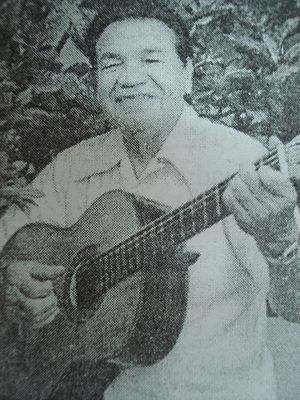Agustín Barboza facts for kids
Quick facts for kids
Agustín Barboza
|
|
|---|---|
 |
|
| Background information | |
| Birth name | Agustín Pío Barboza |
| Born | 5 May 1913 Asunción, Paraguay |
| Died | 18 December 1998 (aged 85) Asunción, Paraguay |
| Genres | Guarania |
| Occupation(s) | Singer, composer |
| Years active | 1998 |
| Labels | Philips |
Agustín Pío Barboza (born May 5, 1913 – died December 18, 1998) was a famous singer and composer from Paraguay. He was known for his beautiful music and for sharing Paraguayan culture with the world.
Contents
Biography
Childhood and early career
Agustín Barboza was born in Asunción, the capital city of Paraguay. When he was a teenager in 1929, Agustín moved to Buenos Aires, Argentina. He worked as a sailor on a ship called the Mixu.
He balanced his work as a sailor with his love for music. He met Basilio Melgarejo Molinas, also known as “Melga.” They started a music duo. Later, they formed a trio called Melgarejo-Barboza-Feliu.
First steps in music
In Buenos Aires, Agustín worked with other talented singers. Some of them were Samuel Aguayo, Emilio Bobadilla Cáceres, and Diosnel Chase. He was a solo singer in orchestras led by Francisco Alvarenga, Juan Escobar, and Julián Alarcón. Juan Escobar and Julián Alarcón were important teachers and guides for him.
In 1933, he sang with José Asunción Flores. A year later, they recorded a song called “Ñasaindype.” This song was based on a poem by Felix Fernandez. It was the very first “Guarania” song ever recorded! Guarania is a special type of Paraguayan music.
Agustín also sang as a soloist with the “Orchestra Ortiz Guerrero.” This famous orchestra included musicians like José Bragato and Gumersindo Ayala Aquino. José Asunción Flores directed the orchestra.
In 1943, Agustín returned to Paraguay with José Asunción Flores and other musicians. They were invited to celebrate Asunción's Foundation Day on August 15. He also formed a trio with Felix Perez Cardozo and Eulogio Cardozo.
In 1944, Agustín received a scholarship from the government. This allowed him to study music at the Rio de Janeiro University in Brazil. He also gave concerts and performed on the radio. During this time, he studied with Carlos Lara Bareiro, who encouraged him to travel and help make Paraguayan music famous.
Travels and becoming popular
In 1947, Agustín traveled from Brazil to Mexico. There, he joined a group called “Los Guaireños.” This group included Luis Alberto del Paraná, Digno Garcia, and Humberto Barua. They performed in Mexico, Cuba, and all over Central America. In the early 1950s, he toured many countries. He visited South America, Central America, Mexico, the United States, and Europe. He performed as a solo artist or with different groups.
In 1954, Luis Alberto del Paraná asked Agustín to join the “Trio Los Paraguayos.” The group also included the harp player Digno Garcia. In Europe, they signed a contract with Philips, a big Dutch record company. This partnership lasted for many years. They became known as the “ambassadors of Paraguayan music” because they shared their country's music with the world.
In 1957, Agustín started his own group called “Barboza y sus compañeros.” The group included Ramón Mendoza, Leonardo Figueroa, and Carlos Centurion. They continued to perform and share their music across Europe and the Middle East.
In 1962, Agustín settled back in Paraguay. He married a singer named Yvera (Francisca Zayas). They became an artistic couple, performing together. In 1968, while in Europe, they formed the group “Los Barboza.” They recorded three albums and performed on radio, television, and in theaters. Their daughter, Diana Barboza, also loved singing. She joined the family group in 1988.
In 1994, the Paraguayan government gave Agustín the National Order of Merit award. This was to honor his hard work in composing and spreading Paraguayan music. In 1996, he wrote a book about his life called Ruego y Camino.
Later years and legacy
In 1997, the national congress gave Agustín the National Award of Music. He won in the popular music category for his song “Mi patria soñada.” The words for this song were written by Carlos Miguel Gimenez.
In 1998, Agustín turned 85 years old. He also celebrated 70 years of making music! To mark this special occasion, he released an album with new versions of his songs. The music was arranged by the famous Oscar Cardozo Ocampo. Agustín received many compliments and praise from people in his home country.
Other works
Agustín Barboza wrote about 80 songs. Some of his most well-known compositions include:
- “Alma vibrante”
- “Flor de Pilar”
- “Mi patria soñada”
- “Sobre el Corazón de mi guitarra”
- “Muchachita campesina”
- “Mis joyas de Buenos Aires” (with words by Carlos Miguel Gimenez)
- “Dulce tierra mía”
- “Serenata”
- “Viva la vida, viva el amor”
- “Muchacha dorada” (with words by Augusto Roa Bastos)
- “Emociones de mi tierra”
- “Ruego y camino”
- “Sombras de ausencia” (with Enrique Ganoso)
- “Voz del viejo río” (with Aníbal Romero)
- “Oimeva che roga”
- “Oñomdiovemi”
- “Reservista purahei” (with Félix Fernández)
See also
 In Spanish: Agustín Barboza para niños
In Spanish: Agustín Barboza para niños

